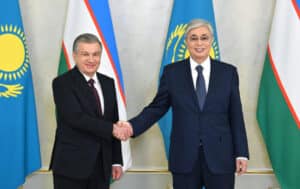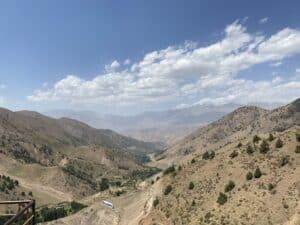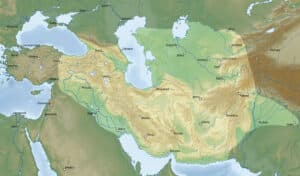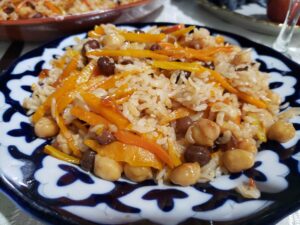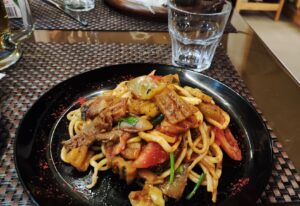When the Silk Road passed through Uzbekistan, its cities grew to some of the world’s largest, most prosperous, and most learned. Many of the great architectural marvels built during those years still stand.
Today, Uzbekistan remains Central Asia’s most populous country. Although mostly desert, it is rich in mineral wealth and its Ferghana Valley is the region’s most agriculturally productive area. As the only state to border all five other Central Asian states, Uzbekistan is expected to be increasingly active in integrating the fractious but strategic region, especially as its new president has made this a stated priority.
Geohistory and Historical Development
Uzbekistan was likely first populated when the world was much cooler and wetter. The area at that time was covered by grasslands. As it dried and warmed, water became scarcer and people adapted by engineering complex and highly efficient irrigation systems.
The drying landscape led to greater distance between communities, requiring more travel to sustain trade. This could be one reason why Central Asians were the first equestrians, allowing them to travel farther and faster overland than anyone had before. Central Asia came to be influenced by cultures as far apart as India, China, and Greece. Multiple languages and religions thrived there along what became “The Silk Road” – a multitude of trade networks that carried many goods across Eurasia, including those produced in Central Asia itself such as paper, textiles, pottery, jewelry, and more.

The Silk Road was not a single road – nor did it only carry silk. It was a complex trade network that stretched from China and India to Europe through Central Asia and carried paper, spices, pottery, gold, silver, and much more.
Wealth from this trade allowed rulers to lavishly support the arts and sciences, leading to a golden age between 800 and 1100. Central Asians made many contributions to mathematics including the invention of algebra and major contributions to trigonometry. They also made major contributions to astronomy, literature, religion, and architecture, including the invention of algebra. They also excelled at languages and translated scientific and philosophical works from many different lands. Much of this work was done in Persian or Arabic, which were then strong regional languages useful for widely spreading information. Because of this, many historians have incorrectly called these authors Persian or Arabic. In reality these thinkers were from the dozens of ethnicities native to this land.
Because of the barren distances between them, governments in Central Asia largely functioned as city states which were sometimes incorporated into larger empires but generally maintained a high degree of autonomy.
In part because of this diversity and autonomy, Islam was slowly adopted after its introduction with the Arab invasions in the 8th century. Islam was also locally adapted to existing beliefs. To this day, Islam in Central Asia still has its own unique elements, influenced in great part by Zorastrianism.
As advances were made globally in maritime technology, Central Asia’s overland Silk Road declined starting in the late 14th century. In parallel, Central Asia had another great flowering from 1370–1507 under the Timurid Empire, which united the area under a local Turkic-speaking empire for the first time and saw additional advances in politics, the military, science, and the arts.
Although the area would never be as powerful again, it largely maintained independence until the Russians invaded in the 19th century. It regained independence after the fall of the USSR.
Much of this history was spread over an area much larger than modern day Uzbekistan – especially in cities now in Turkmenistan and Afghanistan. However, the Uzbeks see all this history as part of their own cultural foundations.
Economy – Agriculture
A little larger than California, modern Uzbekistan is mostly flat desert. Mountains rise in the east, where most of the country’s water sources originate and where most of its population lives. While only 10% of the country can be used for intensive crop farming, agriculture employs 26% of the population and provides 27% of GDP.
Cotton and wheat, both water-intensive crops, are central to the economy. Soviet-era irrigation made this possible, largely using water that would have otherwise fed into the saline Aral Sea. This created the Aral Sea ecological disaster. The shrinking sea could no longer cool the area, leading to rising temperatures. The once important fishing industry was destroyed. Fine dust and salt from the now-dry sea bed is still blown into cities and farm land, creating health problems and reducing crop yields.
- The Aral Sea once hosted an important fishing industry. Today, many ships remain where they were last docked, which today a wide desert plain.
- Satellite photos showing the Aral Sea in 1960 and today. The expanded irrigation systems that helped cause this increased Uzbekistan’s irrigated lands from about 5 to 6.5 million hectares.
- Uzbekistan, despite its lack of water, grows a wide range of crops.
More water-efficient greenhouses for growing fruits and vegetables such as tomatoes and cucumbers for local consumption are increasingly common. However, agricultural reform on a scale that would restore the Aral Sea is not considered possible.
About half of Uzbekistan is desert scrub, and can support sheep and camel production. Industrial yarn, used to produce textiles, is Uzbekistan’s second largest export.
Economy – Minerals and Industry
Gold is, by far, Uzbekistan’s largest export, at about $6 billion a year and drawn from the world’s fourth largest deposits. Copper is the third largest export. Valuable deposits of uranium as well as silver, molybdenum (used in making steel), tungsten, zinc, and lead are also mined.
Uzbekistan’s large and well-educated workforce supports a well-developed industrial base that produces petrochemicals, automobiles (including Chevrolet and Daewoo), machinery (including John Deere tractors), textiles, and processed foods.
Mining and industry employ 30% of the population and produce 30% of GDP.
Economy – Energy, Transport, and Potential Growth
Uzbekistan is a net energy exporter with significant deposits of natural gas, oil, coal, and uranium. Despite a vast potential for solar power, its first plant, a Saudi investment, opened only in 2021. Before that, the only renewable sources of energy came from three hydropower plants in the country’s east. Plans exist to build more solar and wind plants, but considerable investment will be needed to achieve its potential.
Uzbekistan is a double-landlocked country with no sea access and its local rivers flow to inland seas, meaning that the country has very little water transport. Water transport is the the cheapest and most efficient transport means and often needs no additional infrastructure. Most of the world’s major economies today got a boost in some way from river transport and access to international markets via ocean access. Uzbekistan’s international river transport is largely limited to Afghan routes.
- Traditional crafts, often made with the same techniques that they were made during the times of the Silk Road, are still important to the economy. They are both exported and sold locally, especially as part of Uzbekistan’s growing tourism industry.
- Handmade plates with traditional designs and glazing.
- Uzbekistan’s metal and coal deposits mean that the country has also had a long tradition of metalurgy. These knives are handmade.
Without water transport, Uzbekistan is focusing on rail, the second most efficient. It has created an extensive high speed domestic rail system and is working with international partners to build new lines to increase connectivity and, eventually, access to ocean-accessible ports – in India, Iran, or Georgia. While most of these new lines are still theoretical, a line through Kyrgyzstan to China has already been announced and further expansion is planned.
Internally, a new bypass connecting the fertile Ferghana Valley and central Uzbekistan without the need to cross into Tajikistan was finished in 2016. This irked Tajikistan, which had often used the transit rights as a bargaining chip in relations with Uzbekistan.
Uzbekistan is also part of the Turkmen-China Pipeline, completed in 2009, which allows diversification away from Russia and towards China for natural gas sales. Europe is also now looking for ways to directly import Central Asian gas, which would benefit Uzbekistan.
Uzbek airports, even in the capital, are small. However, expansion in air freight and tourist passenger flights is possible. Most major population centers and industrial zones are accessible by public roads in generally good condition.
For growth, most observers still agree that much more could be done to liberalize and streamline agriculture, encourage exports and SMEs, invest in energy efficiency and renewables, and better develop the country’s internal transport networks.
Society and Demographics
Uzbekistan’s population of 35 million is larger than that of the rest of Central Asia combined. With a fertility rate that has stayed above 2 throughout recent history, the population is growing and getting younger due to births and a significant emigration of older individuals seeking opportunity abroad.
About half of Uzbekistan’s population is rural. Despite fairly consistent economic growth for more than two decades, most Uzbeks are quite poor.
Ethnic Uzbeks account for 80% of the population. The Karakalpaks, the only major indigenous minority, have nearly doubled since 1989 but still account for only about 2% of the population, concentrated in an eponymous, semi-autonomous republic that accounts for 40% of Uzbekistan’s total territory. The region is arid and poor but has enjoyed cultural and linguistic freedom. The Karakalpaks have not been very active politically, with the notable exception of the 2022 Karakalpak Protests that erupted when the Uzbek president proposed removing the region’s constitutional autonomy. The protests were quelled only with a declared state of emergency.
- SRAS students photographed with a large group of school children who study English in Uzbekistan. Uzbekistan has a fertility rate of 2.9, well above the global average.
- Young people display modern fashions with traditional print designs and fabrics.
- Uzbeks attending an Islamic outdoor prayer service. Uzbekistan is more than 90% Muslim.
Other minorities include growing numbers of Kyrgyz and Tajiks, stable numbers of Kazakhs and a shrinking number of Russians (to about half their 1989 population).
Russian remains taught in schools and is widely spoken in major cities, along with Uzbek. Grocery store labels are often in Russian. Although Uzbekistan adopted the Latin alphabet in 1992, it did not abandon Cyrillic, which remains most common.
More than 90 percent of the country is Muslim. The growing popularity and influence of religion comes with some fears of radicalization, particularly from groups in neighboring Afghanistan such as ISIS.
Briefly on Politics
Under former president Islam Karimov, Uzbekistan became increasingly isolated. He continued various soviet policies such as retaining state ownership of land and major industries, state production quotas and set prices, and conscripting labor, including school children, to help with the annual cotton harvest. This led many international clothing brands to boycott Uzbek cotton. Karimov, however, remains hugely popular in Uzbekistan and is credited with successfully guiding the country through the fall of Communism and to its current state of development.
Shavkat Mirziyoyev came into the presidency in 2016 promising to open the country. He quickly gained a reputation as a hands-on and energetic president, widely touring the country, consolidating his power, and making sure his reforms were being implemented. He also gained visits to many western and eastern countries, including the US.
Reforms have been increasing difficult to implement. For instance, although the state no longer presses for help in the cotton harvest, local bureaucrats, schoolheads, and others with power reportedly still do.
- A grand mausoleum was built for Islam Karimov after his death. He is still revered highly in Uzbekistan.
- A statue of Uzbekistan’s first president, Islam Karimov, in Samarkand’s Registan Park.
- Shavkat Mirziyoyev, left, meets with President Kassym-Jomart Tokayev of Kazakhstan. Relations have been warming under the two rulers.
Regional Relations with Bordering Countries
Kazakh relations have been stable and prosperous. All border disputes were resolved by 2019. A formal alliance declared in 2021 has resulted in escalating trade and deeper integration between Central Asia’s two largest and most powerful states.
Turkmen relations were dangerously sour after the fall of the USSR, with border disputes and accusations of assassination plots. After changes in power in both countries, relations are mostly characterized by mutual trade and infrastructure talks.
Uzbekistan, Kyrgyzstan, and Tajikistan have Soviet-created enclaves of territory within the others. These have been a source of tension.
Kyrgyz relations are complicated by border disagreements, the treatment of Uzbek minorities in Kyrgyzstan and vice versa. Uzbekistan supplies most of the gas used by southern Kyrgyzstan. Kyrgyzstan aims to develop more hydroelectric power from rivers that flow to Uzbekistan, which worries this would impact its agricultural sector.
Similarly, Uzbekistan once threatened war over the Rogun Dam in Tajikistan. Tajikistan is also highly dependent on Uzbek gas. Tajikistan was also upset by the construction of the Kamchik rail line that allows internal Uzbek lines to bypass Tajik territory, further isolating Tajikistan and depriving it of customs duties. Relations have improved under Uzbekistan’s current president, who has focused on business and profits.
Afghanistan shares a small border with Uzbekistan. During the US occupation of Afghanistan, Uzbekistan provided transport routes and power for the country. Today, although Uzbekistan has not formally recognized the Taliban, it maintains contacts to help secure the border and facilitate trade and diplomacy.
- A topographical map of Uzbekistan showing some of the surrounding countries.
- SRAS Program Director Renee Stillings in front of an ancient Khorezm fortress in western Uzbekistan. Much of the country is flat or rolling desert.
- The rugged mountains of the Fergana Region of eastern Uzbekistan.
Other Foreign Relations
US relations hit a low in 2005, when, after US criticism of the Andijan Massacre, Uzbekistan forced the US to close its military base in Uzbekistan. Especially since 2019, relations have improved, with the US providing aid to improve transport links to Afghanistan and push against drug and human trafficking from Afghanistan.
Russia’s state-owned Gazprom controls Uzbekistan’s pipelines. Russia is one of two routes for Uzbek gas export and the source of 55% of remittances from Uzbeks working abroad to support their families at home. Remittances make up ~12% of Uzbek GDP. Russia is Uzbekistan’s second largest trading partner. Although Uzbekistan left the Russia-led CSTO in 2019, the countries maintain good relations.
China is Uzbekistan’s largest trading partner and increasingly a source of loans and funding for infrastructure. Uzbekistan is working with Kyrgyzstan to sponsor a much awaited rail project linking China to Uzbekistan through Kyrgyzstan. Later expansions may extend through Turkmenistan to Iran. Connecting Central Asia to eastern Asia and India has long been seen as something as major economic and political goal – but has been spoiled by internal rivalries in Central Asia and instability in Afghanistan and Pakistan.
Turkey is Uzbekistan’s fourth largest trading partner. Turkey has recently increased investments to Uzbekistan, building new thermal and natural gas electric plants. The two countries have recently signed a Comprehensive Strategic Partnership agreement that should help boost investment and trade further. Both are also members of the Organization of Turkic States, which strives to coordinate economic and diplomatic activities between states with Turkic heritage.
Cultural and Identity Markers
The most revered person in Uzbek history is Timur (Tamerlane), the Turco-Mongol conqueror who founded the Bukhara-based Timurid Empire,the first Turkic-speaking empire. Tamerlane is remembered as a great statesman who built monuments, lavishly supported scientists and craftsmen, collected over 600,000 books and made traveling the Silk Road safe, and made Samarkand a world-famous cultural and commercial center.
- The Timurid Empire at its height in 1405.
- A very large statue of Timur in Shakhrisabz, a city built by Timur to be major city showcasing his weath and power. Today, most lies in ruins but is being developed as a tourist destination.
- A monument to Timur on Tashkent’s Amir Timur Square.
Ulugbeg was the grandson of Timur, and is remembered as a “king astronomer” who valued education and science over religion and war. He opened his madrasas to men and women, locals and foreigners, Muslims and non-Muslims alike. During his 40 years of rule, no battles were fought, but schools were built and scientists supported.
Babur was another descendent of Timur, born in the Fergana Valley in 1483. He went on to found the Mughal Empire in India and is also highly regarded.
Uzbeks also count among their own many famous scientists that worked or were born within historical empires, but are not all, strictly speaking, Uzbek. This includes figures like Muḥammad ibn Mūsā al-Khwārizmī, a 9th-century Muslim mathematician and astronomer who introduced Hindu-Arabic numerals to Europe and is credited with inventing algebra. His name means “the native of Khwarazm,” a region that was part of Greater Iran, and is now part of Turkmenistan and Uzbekistan.
Uzbekistan has a national epic called Alpamysh, which also spans other Kipchak Turks’ cultures. The tale follows Alpamys and his bride Barchin, how they court, are wed, are separated, and eventually reunited. In the process, Alpamys exemplifies strength, wisdom, and bravery. Today, professional ashiqs still learn and perform the epic to music on traditional instruments, as it was handed down for many generations.
Alpomish also features endless battles, a feature of life at the time as Bukhara, Samarkand, and Khiva were rich prizes for enemy armies and have been among the most invaded places in the world. Alpomish shows that under these conditions, people dream of a hero to unite and protect them, which remains an enduring trope in Uzbek culture and politics.
The author with perhaps the most influence on modern literature is Abdulla Qodiriy, who lived and worked in the early twentieth century. He argued that Uzbekistan should be independent and develop on its own terms. In 1938 he was shot by the Soviets though he was officially sentenced to death only weeks later. Today, Abdulla Qodiriy remains one of Uzbekistan’s most widely read and known authors.
Three very common names in Uzbekistan remain Timur, Ulugbeg, and Abdulla.
Uzbekistan takes its culinary traditions seriously. The main national dish is plov, a hearty mix of rice, meat, carrots, and onions cooked in oil. It first became widely popular under the Abbasid Caliphate. Uzbekistan’s main national dumplings are manti: large, steamed dough packets filled with meat, onions and spices. Similar is the samsa – a large, baked dough packet filled with meat, onions, and spices. Lagman can be either a pasta soup or pasta topped with stewed meat, tomatoes, onions, and spices.
- Pictured is “Wedding Plov” a festive version of plov that features chick peas, raisins, and carrots.
- By far, Uzbekistans best known landmark is Registan Square in Samarkand.
- Pictured is a very hearty version of lagman, with lots of meat and vegetables.
Uzbek cuisine is known as being meat and grain heavy. Often the only salad available is a small cucumber, tomato, and onion mix. Deserts are also sparse, but still enjoyable – tea served with fruit (fresh, stewed, or dried) and nuts and/or halva (an arabic sweet made from seeds or nuts). Halva likely originated in Iran, but is popular throughout Central Asia.
Uzbek holidays are dominated by Ramadan, New Year’s (for which Uzbeks get four days off), and Nowruz, a holiday of Zorastrain descent popular in many countries once dominated by or near to the former Persian empire.
You Might Also Like

Central Asia: Core and Periphery
Central Asia is, by its most common definition, those five “stans” that were formerly Soviet republics: Kazakhstan, Kyrgyzstan, Tajikistan, Turkmenistan, and Uzbekistan. However, this has…

Uzbekistan: A GeoHistory Study Guide
When the Silk Road passed through Uzbekistan, its cities grew to some of the world’s largest, most prosperous, and most learned. Many of the great…

The Silk Road Railway: Will It Ever Happen?
In June 2022, the governments of China, Kyrgyzstan, and Uzbekistan announced that construction on the long-awaited Silk Road Railway will begin in early 2023. A…

A Comparative Look at Coronavirus Responses in Eurasia
The global health crisis has changed life around the world, but in often very different ways in various places. Even countries located close to each…

4 Cities in Uzbekistan: One of the World’s Ancient Civilizations
Uzbekistan is a country that holds a very special place in my heart. I grew up in Uzbekistan but left due to political issues in…















